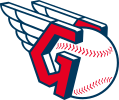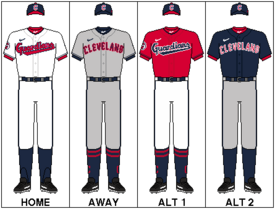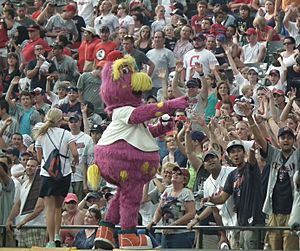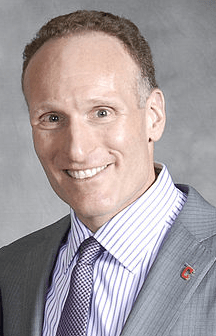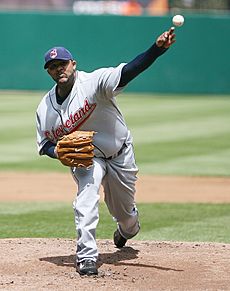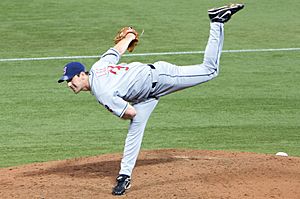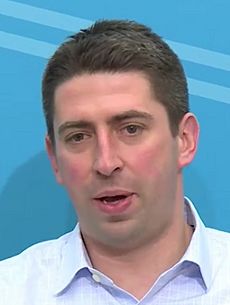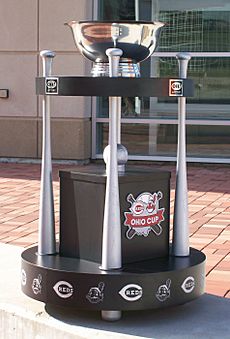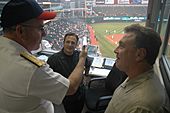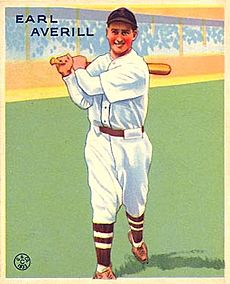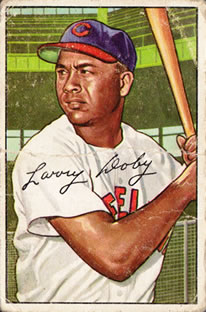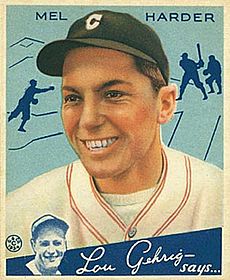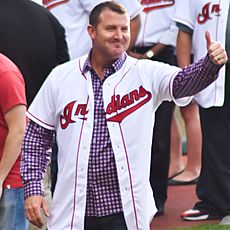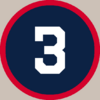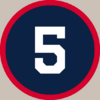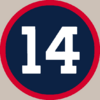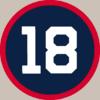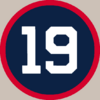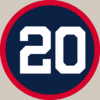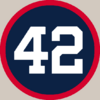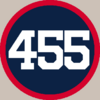Cleveland Guardians facts for kids
Quick facts for kids Cleveland Guardians |
|||||
|---|---|---|---|---|---|
|
|||||
|
|||||
| Major league affiliations | |||||
|
|||||
| Current uniform | |||||
| Retired numbers | |||||
| Colors | |||||
|
|||||
| Name | |||||
|
|||||
| Ballpark | |||||
|
|||||
| Major league titles | |||||
| World Series titles (2) |
|
||||
| AL Pennants (6) |
|
||||
| AL Central Division titles (11) |
|
||||
| Wild card berths (2) |
|
||||
| Front office | |||||
| Principal owner(s) | Larry Dolan Paul Dolan (Chairman/CEO) |
||||
| President of baseball operations | Chris Antonetti | ||||
| General manager | Mike Chernoff | ||||
| Manager | Terry Francona | ||||
The Cleveland Guardians are a professional baseball team from Cleveland, Ohio. They play in Major League Baseball (MLB) as part of the American League (AL) Central division. Since 1994, their home field has been Progressive Field.
The team started as a major league franchise in 1901. Since then, they have won 11 division titles, six American League pennants, and two World Series championships in 1920 and 1948. The Guardians have the longest current World Series championship drought among all 30 MLB teams, as they haven't won since 1948.
The team's name comes from the Guardians of Traffic. These are eight large sculptures from 1932 by Henry Hering on the city's Hope Memorial Bridge, which is right next to Progressive Field. The team's mascot is named "Slider." They do their spring training at Goodyear Ballpark in Goodyear, Arizona.
The team began in 1894 as the Grand Rapids Rippers, a minor league team in Grand Rapids, Michigan. In 1900, the team moved to Cleveland and was called the Cleveland Lake Shores. The league they played in, the Western League, changed its name to the American League in 1900. In 1901, the American League became a major league, and Cleveland was one of its first eight teams. They were first called the Cleveland Bluebirds or Blues, and sometimes the Cleveland Bronchos in 1902. From 1903, the team was known as the Cleveland Napoleons or Naps, named after their star player, Nap Lajoie.
After Lajoie left in 1914, the team owner asked baseball writers to pick a new name. They chose the name Cleveland Indians. This name was a nod to the Cleveland Spiders team, which fans called "Indians" when Louis Sockalexis, a Native American player, was on the team. The name "Indians" was used for over a century. Common nicknames for the Indians were the "Tribe" and the "Wahoos," which referred to their old logo, Chief Wahoo. After facing criticism, the team stopped using the "Indians" name after the 2021 season and became the "Guardians" in 2022.
From August 24 to September 14, 2017, the team won 22 games in a row. This is the longest winning streak in American League history and the second longest in MLB history. As of the end of the 2022 season, the team's overall record is 9,684 wins and 9,214 losses.
Contents
- Early Baseball in Cleveland
- Team History
- Team Rivalries
- Team Colors and Uniforms
- Team Media
- Popular Culture
- Awards and Honors
- Team Records
- Minor League Teams
- Images for kids
- See also
Early Baseball in Cleveland
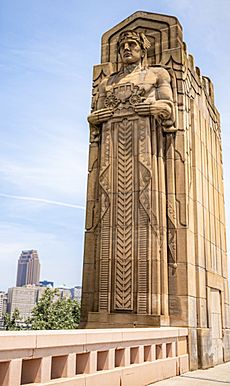
Baseball has a long history in Cleveland.
- 1865–1872 Forest Citys of Cleveland: From 1865 to 1868, the Forest Citys were an amateur team. In 1869, they became a professional team. In 1871, they joined the National Association (NA), the first professional baseball league. The team stopped playing in 1872.
- 1879–1884 Cleveland Forest Citys / Blues: In 1879, Cleveland got a new team in the National League (NL). They were called the Cleveland Forest Citys, but changed to the Cleveland Blues in 1882. The Blues had average seasons and struggled when some of their best players left for another league. The team merged with a St. Louis team in 1885.
- 1887–1899 Cleveland Spiders: Cleveland didn't have a major league team for two years. Then, in 1887, they joined the American Association. In 1889, they moved to the NL and became the Cleveland Spiders. The Spiders got their name because their players were described as "skinny and spindly." In 1891, the Spiders moved into League Park, which was Cleveland's baseball home for 55 years.
Led by star pitcher Cy Young, the Spiders became a strong team in the mid-1890s. They played in the Temple Cup Series (like the World Series back then) twice and won it in 1895. However, the team declined after this success. In 1899, the Spiders' owner also bought the St. Louis Browns. He moved most of Cleveland's best players, including Cy Young, to St. Louis. This left the Spiders with a very weak team. They lost a record 134 games that year and were often called "The Wanderers" because they played most of their games away from home due to low attendance. After the 1899 season, the National League disbanded the Spiders.
- 1890 Cleveland Infants: The Cleveland Infants played in the Players' League for just one season in 1890. They finished with 55 wins and 75 losses.
Team History
The Early Years: 1894–1935
The team started as the Grand Rapids Rippers in Michigan in 1894. In 1900, they moved to Cleveland and were called the Cleveland Lake Shores. The Western League, a minor league, changed its name to the American League that same year. In 1901, the American League declared itself a major league. The Cleveland team, then called the Cleveland Bluebirds or Blues, was one of its first teams. Cleveland is one of only four teams still in its original city from that time.

The team was owned by Charles Somers and Jack Kilfoyl. Somers, a rich businessman, helped other teams financially to keep the new league going. Players didn't like the name "Bluebirds" or the unofficial "Blues." They even tried "Broncos" in 1902, but it didn't stick.
Cleveland had money problems in its first two seasons. Somers even thought about moving the team. Help came in 1902 when star second baseman Nap Lajoie joined the team. He was a huge hit, drawing many fans. In 1903, the team was named the Cleveland Napoleons or Naps after a newspaper contest.
Lajoie became manager in 1905, and the team improved, nearly winning the pennant in 1908. But success didn't last, and Lajoie resigned as manager in 1909, though he kept playing. The team struggled, and Somers sold his share. Key players like Cy Young and Addie Joss left or passed away.
Despite good hitters like Lajoie and Shoeless Joe Jackson, poor pitching kept the team from winning. They finished last in 1914 and 1915. In 1915, Lajoie was traded. The team needed a new name. Somers asked local baseball writers, and they chose the Cleveland Indians. This name honored the nickname given to the old Cleveland Spiders when Louis Sockalexis, a Native American player, played for them.
Somers also had financial troubles and sold the team to James C. "Jack" Dunn. New manager Lee Fohl brought in pitchers Stan Coveleski and Jim Bagby, Sr., and traded for star outfielder Tris Speaker. These players would help bring a championship to Cleveland.
Speaker became player-manager in 1919 and led the team to a championship in 1920. On August 16, 1920, during a game, Cleveland shortstop Ray Chapman was hit in the head by a pitch and sadly passed away the next day. He is the only MLB player to die from an injury during a game. The Indians, who were in a close race for the pennant, continued to play hard. Rookie Joe Sewell took Chapman's place.
In September 1920, the Black Sox Scandal came to light, where some Chicago White Sox players were accused of fixing games. This helped the Indians win the pennant. Cleveland finished two games ahead of Chicago. They then defeated the Brooklyn Robins 5–2 in the 1920 World Series for their first title. Game 5 of that series had three amazing "firsts": Elmer Smith hit the first Series grand slam, Jim Bagby hit the first Series home run by a pitcher, and Bill Wambsganss made the first (and only) unassisted triple play in World Series history.
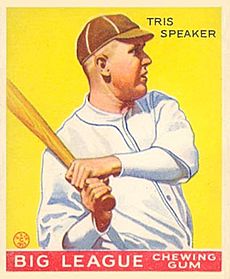
The team didn't win another championship for 28 years. Speaker and Coveleski got older, and the Yankees became very strong. The Indians finished second a couple of times but spent most of the 1920s near the bottom. In 1927, the team was sold to a group led by Alva Bradley.
The Feller Years: 1936–1946
In the 1930s, the Indians were an average team. In 1936, a new star arrived: 17-year-old pitcher Bob Feller from Iowa, known for his powerful fastball. Feller set a record with 17 strikeouts in one game that season and led the league in strikeouts for several years.
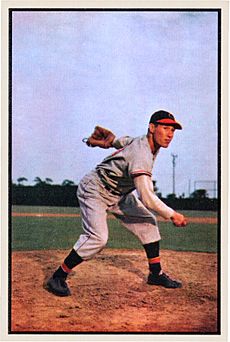
In 1940, Feller, along with Ken Keltner, Mel Harder, and Lou Boudreau, led the Indians to within one game of winning the pennant. However, there were disagreements within the team. Feller, who had won 27 games, lost the final game of the season, and the Detroit Tigers won the pennant.
The team struggled in 1941. Cleveland lost two stars when Hal Trosky retired and Bob Feller joined the Navy after the Attack on Pearl Harbor. Other players also joined the military during World War II.
The Bill Veeck Era: 1946–1949
In 1946, Bill Veeck bought the Cleveland Indians. Veeck was known for his exciting promotions. He moved the team to the much larger Cleveland Municipal Stadium full-time. This stadium allowed the Indians to set a record for the largest crowd at a Major League baseball game, with over 84,000 fans at a 1948 World Series game.
One of Veeck's most important actions was breaking the color barrier in the American League. In 1947, he signed Larry Doby, who became the first black player in the AL, just 11 weeks after Jackie Robinson joined the Dodgers. Doby faced challenges but became a great player. In 1948, Veeck also signed pitching legend Satchel Paige from the Negro leagues. Paige, at age 42, became the oldest rookie in MLB history and the first black pitcher.
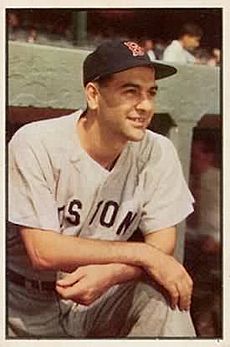
In 1948, the team, led by Boudreau, Keltner, and Joe Gordon, had amazing seasons. Doby and Gene Bearden also played very well. The team won a one-game playoff against the Boston Red Sox to reach the 1948 World Series. In the World Series, the Indians defeated the Boston Braves four games to two, winning their first championship in 28 years. Boudreau won the American League MVP Award.
The team appeared in a movie called The Kid From Cleveland in 1949. However, filming during the season tired out the players. Cleveland finished third that season. Later in 1949, Veeck had to sell the team due to a divorce settlement.
Near Misses: 1950–1959
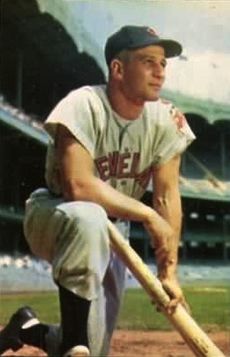
In 1953, Al Rosen was named the American League Most Valuable Player. The team had many talented players like Feller, Doby, Minnie Miñoso, Luke Easter, Bobby Ávila, Rosen, Early Wynn, Bob Lemon, and Mike Garcia. They were strong contenders throughout the early 1950s. However, Cleveland only won one pennant in this decade, in 1954, and finished second to the New York Yankees five times.
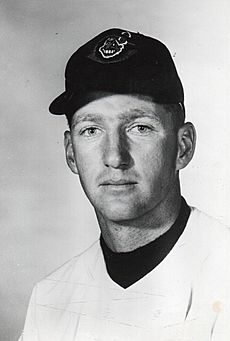
The 1954 season was the winningest in franchise history, with 111 wins and 43 losses. This set an American League record for wins. The Indians returned to the 1954 World Series but were upset by the New York Giants in a sweep. The series is famous for Willie Mays' amazing over-the-shoulder catch. Cleveland remained a talented team, finishing second in 1959.
The Long Slump: 1960–1993
From 1960 to 1993, the Indians mostly finished at or near the bottom of the standings. They had four seasons with over 100 losses.
"Trader" Lane and the Rocky Colavito Trade
In 1957, the Indians hired general manager Frank Lane, known as "Trader" Lane because he loved to make deals. One of his most famous trades was sending popular slugger Rocky Colavito to the Detroit Tigers for Harvey Kuenn in 1960. This trade was very unpopular with fans. Colavito continued to hit many home runs for other teams, while Kuenn only played one season for Cleveland. This trade is often linked to the team's struggles for decades afterward, known as the "Curse of Rocky Colavito." Colavito himself said he never cursed the team.
Lane also made a unique trade of managers in 1960, sending Joe Gordon to the Tigers for Jimmy Dykes. Even after Lane left in 1961, the team continued to make trades that didn't work out.
Struggles and Changes
The 1970s were also tough. The Indians traded away future stars like Graig Nettles and Dennis Eckersley for players who didn't make much impact. The team also had many different owners during this time. In 1975, Cleveland made history by hiring Frank Robinson as Major League Baseball's first African American manager. Robinson also played for the team and hit a home run on Opening Day. However, the team didn't improve much under his leadership, and he was fired in 1977.
The 1970s also saw the infamous Ten Cent Beer Night in 1974, where a promotion led to problems with fans.
There were some good moments in the 1980s. In 1981, Len Barker threw a perfect game, meaning no opposing player reached base. Joe Charboneau won the American League Rookie of the Year award. However, both players faced injuries and didn't have long careers.
The team's struggles were even featured in the 1989 movie Major League, which showed a funny story about a bad Cleveland team that turns things around.
Throughout the 1980s, the team's owners wanted a new stadium. The old Cleveland Stadium was falling apart. In 1990, voters approved a tax to build the Gateway Sports and Entertainment Complex, which would include a new stadium for the Indians.
The team's luck started to change in 1989 with a trade that brought in Sandy Alomar Jr. and Carlos Baerga. Alomar became an immediate star, winning Rookie of the Year and a Gold Glove. Baerga also became a three-time All-Star. General manager John Hart made more good moves, like hiring former Indian Mike Hargrove as manager in 1991 and trading for Kenny Lofton, who became a speedy outfielder. In 1992, the team was named "Organization of the Year" for its improving players.
In 1993, the team faced a tragedy during spring training when a boat accident killed pitchers Steve Olin and Tim Crews, and seriously injured Bob Ojeda. Despite this, the team was building a strong group of young players as they prepared to move into their new stadium.
New Beginnings: 1994–2001
1994: Progressive Field Opens
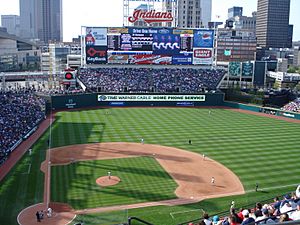
The Indians opened Jacobs Field in 1994. They were playing well, just one game behind the division leader, when a players strike ended the season early.
1995–1996: Back to the World Series
In 1995, the Indians had an amazing season, winning 100 games in a shortened season and their first-ever division title. Veteran players like Dennis Martínez and Eddie Murray joined young stars like Omar Vizquel, Albert Belle, Jim Thome, Manny Ramírez, Kenny Lofton, and Charles Nagy. The team led the league in hitting and pitching.
They defeated the Boston Red Sox and Seattle Mariners to win the American League pennant, reaching the World Series for the first time since 1954. However, they lost the 1995 World Series in six games to the Atlanta Braves.
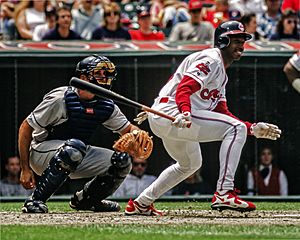
In 1996, tickets for every home game sold out months in advance. The Indians won their division again but lost to the Baltimore Orioles in the playoffs.
1997: So Close to a Championship
In 1997, Cleveland started slowly but finished strong, winning their third straight division title. They defeated the New York Yankees and Baltimore Orioles to reach the 1997 World Series against the Florida Marlins. The series was tied going into Game 7. The Indians had a 2–1 lead in the ninth inning, but the Marlins tied the game and then won it in the eleventh inning. Cleveland became the first team to lose the World Series after having the lead in the ninth inning of Game 7.
1998–2001: More Playoff Appearances
In 1998, the Indians made the playoffs for the fourth year in a row. They beat the Boston Red Sox but then lost to the New York Yankees, who had won 114 games that season.
For the 1999 season, the Indians added Roberto Alomar and won their fifth straight division title. They scored over 1,000 runs, a rare achievement. However, they lost to the Red Sox in the first round of the playoffs, even after leading the series 2–0.
In 2000, the Indians finished strong but missed the playoffs by one game. After the season, star hitter Manny Ramírez left the team. In 2000, Larry Dolan bought the Indians for $320 million, a record price at the time.
The 2001 season saw the team return to the playoffs. They won the Central division with a 91–71 record. A highlight was on August 5, when the Indians made the biggest comeback in MLB history. They came back from being down 14–2 in the seventh inning to beat the Seattle Mariners 15–14 in 11 innings. The Mariners and Indians met in the first round of the playoffs, but Seattle won the series 3–2. After the season, general manager John Hart resigned, and Mark Shapiro took over.
Rebuilding and New Success: 2002–Present
Rebuilding the Team
Mark Shapiro began to rebuild the team by trading older players for younger talent. He traded Roberto Alomar and Bartolo Colón for promising young players like Brandon Phillips, Cliff Lee, and Grady Sizemore. Star player Jim Thome also left after the 2002 season.
The young Indians teams finished out of contention in 2002 and 2003 under new manager Eric Wedge. In 2004, they had good hitting but struggled with their bullpen. A memorable game was a 22–0 win over the New York Yankees.
In 2005, the Indians had a great August, closing a large gap in their division. However, they lost six of their last seven games and missed the playoffs by just two games. Shapiro was named Executive of the Year. In 2006, the team had a strong offense, led by Travis Hafner and Grady Sizemore, but their bullpen continued to struggle.
In 2007, the Indians improved greatly and made it to the playoffs for the first time since 2001. They finished with 96 wins, tied for the best record in baseball. They defeated the New York Yankees in the first round of the playoffs. They then took a 3–1 lead over the Boston Red Sox in the American League Championship Series but lost the last three games, ending their season.
Despite the loss, Cleveland players won several awards. Grady Sizemore won a Gold Glove. Pitcher CC Sabathia won the Cy Young Award, given to the best pitcher. Eric Wedge won Manager of the Year, and Shapiro was again named Executive of the Year.
More Rebuilding
The 2008 Indians struggled with injuries to key players. They traded CC Sabathia and Casey Blake for new prospects. Pitcher Cliff Lee had an amazing season, winning 22 games and the AL Cy Young Award. Grady Sizemore also had a great year, winning a Gold Glove and a Silver Slugger Award. The team finished with an 81–81 record.
The 2009 season was also tough. The team made more trades, sending Cliff Lee and Victor Martinez to other teams for more prospects. The Indians finished with a 65–97 record. Eric Wedge and his coaching staff were let go, and Manny Acta was hired as the new manager. In 2010, Mark Shapiro was promoted to team President, and Chris Antonetti became the new General Manager.
The Francona Era: 2011–Present
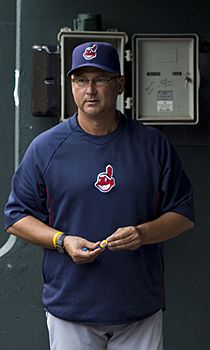
In 2011, the Indians started strong but then faced injuries. They traded for star pitcher Ubaldo Jiménez. Jim Thome also returned to the team for a short time. The Indians finished second in their division.
In 2012, the Indians played the longest Opening Day game in MLB history, lasting 16 innings. Later that year, Manny Acta was fired, and Sandy Alomar Jr. became interim manager. In October, Terry Francona, who had led the Boston Red Sox to two World Series titles, was hired as the new manager for 2013.
The 2013 Indians made many changes to their roster, adding players like Nick Swisher and Michael Bourn. They improved their win total by 24 games from the previous year, finishing second in their division and making the playoffs for the first time since 2007. They lost their playoff game to Tampa Bay. Francona won the American League Manager of the Year Award for the team's turnaround.

In 2014, the Indians had another winning season but missed the playoffs. In 2015, they had their third straight winning season. After Mark Shapiro left, Chris Antonetti became President of Baseball Operations, and Mike Chernoff became General Manager.
The Indians set a franchise record in 2016 by winning 14 games in a row. They clinched their division title, their first since 2007, and returned to the playoffs. They swept the Boston Red Sox and defeated the Toronto Blue Jays to win their sixth American League pennant, advancing to the 2016 World Series against the Chicago Cubs. The Indians took a 3–1 lead in the series, but the Cubs came back to win the last three games and the championship. Francona won his second AL Manager of the Year Award.
From August 24 to September 15, 2017, the Indians set a new American League record by winning 22 games in a row. They won 100 games that season, only the third time in team history. They won their division again but lost to the New York Yankees in the playoffs.
In 2018, the Indians won their third straight division title but were swept by the Houston Astros in the playoffs. In 2019, they missed the playoffs. The 2020 season was shortened due to the COVID-19 pandemic. The Indians made the expanded playoffs but were swept by the New York Yankees.
On December 18, 2020, the team announced they would drop the "Indians" name after the 2021 season. On July 23, 2021, they announced their new name would be the Cleveland Guardians. They officially became the Guardians on November 19, 2021.
In their first season as the Guardians, in 2022, the team won the AL Central Division Championship, their 11th division title in franchise history.
Team Rivalries
Interleague Rivalries
The Guardians have a rivalry with the Cincinnati Reds, another Ohio team. This is known as the Battle of Ohio or Buckeye Series. The winner of their season series gets the Ohio Cup trophy. Before 1997, they played one pre-season game for the cup. Since 1997, they play each other during the regular season. The Guardians lead the series against the Reds.
They also have an on-and-off rivalry with the Pittsburgh Pirates because the cities are close. Starting in 2023, they will play a three-game series each season.
Divisional Rivalries
The Guardians play many games each year against their AL Central division rivals, leading to several rivalries.
- Detroit Tigers: This is a geographic rivalry, especially when both teams are fighting for the AL Central title.
- Chicago White Sox: This rivalry goes back to 1959. It became more intense when both teams moved to the AL Central in 1994. There was a famous incident in 1994 when the White Sox took Albert Belle's bat, and a Guardians pitcher tried to get it back.
Team Colors and Uniforms
The official team colors are navy blue, red, and white.
- Home Uniforms: The main home uniform is white with navy blue trim on the sleeves. It has the "winged G" logo on the right sleeve. The word "Guardians" is written in red with a navy blue outline across the front. Players wear navy blue undershirts, belts, and socks. There is also an alternate red home jersey with "Guardians" in navy blue trimmed in white.
- Home Cap: The home cap is navy blue with a red bill and a red "diamond C" logo on the front.
- Road Uniforms: The main road uniform is gray. It has "Cleveland" written in navy blue letters with red trim across the front. It also has the "winged G" logo on the right sleeve and navy blue trim on the sleeves. Players wear navy blue undershirts, belts, and socks. There is an alternate navy blue road jersey with "Cleveland" in red letters trimmed in white.
- Road Cap: The road cap is similar to the home cap, but the bill is navy blue.
- Batting Helmet: For all games, the team uses a navy blue batting helmet with a red "diamond C" on the front.
Team Media
Radio and TV
You can listen to Guardians games on Cleveland radio stations WTAM (1100 AM/106.9 FM) and WMMS (100.7 FM). Tom Hamilton and Jim Rosenhaus call the games.
For television, games are shown on Bally Sports Great Lakes. Matt Underwood is the lead announcer, and former Indians player Rick Manning is the analyst. Some games are also shown on WKYC channel 3.
Famous Announcers
Many famous broadcasters have worked for the team, including Jack Graney (the first former player to become a play-by-play announcer), Jimmy Dudley, Mike Hegan, and Herb Score, who was with the team for 34 seasons.
Popular Culture
The team has been featured in several films:
- The Kid from Cleveland – a 1949 movie with the team's owner and many players.
- Major League – a 1989 comedy film about a fictional version of the Indians.
- Major League II – a 1994 sequel to the first movie.
Awards and Honors
Baseball Hall of Famers
Many players who played for the Cleveland Naps or Indians have been inducted into the Baseball Hall of Fame. Some of them include:
- Elmer Flick
- Addie Joss
- Nap Lajoie
- Cy Young
- Roberto Alomar
- Earl Averill
- Lou Boudreau
- Stan Coveleski
- Larry Doby
- Bob Feller
- Joe Gordon
- Bob Lemon
- Satchel Paige
- Gaylord Perry
- Frank Robinson
- Joe Sewell
- Tris Speaker
- Jim Thome
- Early Wynn
Retired Numbers
|
- Jackie Robinson's number 42 is retired across all of Major League Baseball.
- The number 455 was retired to honor the fans after the team sold out 455 games in a row between 1995 and 2001. This was an MLB record for a while.
Statues and Murals
Several former Naps/Indians players have statues in Cleveland:
- Bob Feller (since 1994)
- Jim Thome (since 2014)
- Larry Doby (since 2015)
- Frank Robinson (since 2017)
- Lou Boudreau (since 2017)
- Elmer Flick (in Bedford, Ohio, since 2013)
- Luke Easter (outside his namesake park since 1980)
- Rocky Colavito (in Little Italy, Cleveland, since 2021)
In 2022, a mural was added to the outside of Progressive Field. It honors players like Larry Doby, Frank Robinson, and Satchel Paige who broke barriers in baseball while playing for the team.
Parks and Fields
Several youth baseball fields in Cleveland are named after former and current players:
- Luke Easter Park (named in 1980)
- Jim Thome All-Star Complex (2019)
- CC Sabathia Field at Luke Easter Park (2021)
- José Ramírez Field (opening in 2023)
Team Records
- Highest batting average: .408, Joe Jackson (1911)
- Most runs: 140, Earl Averill (1930)
- Most home runs: 52, Jim Thome (2002)
- Most RBIs: 165, Manny Ramirez (1999)
- Most stolen bases: 75, Kenny Lofton (1996)
- Most wins by a pitcher: 31, Jim Bagby, Sr. (1920)
- Lowest ERA by a pitcher: 1.16, Addie Joss (1908)
- Most strikeouts by a pitcher: 348, Bob Feller (1946)
- Most saves: 46, José Mesa (1995)
- Longest team win streak: 22 games (2017)
Minor League Teams
The Cleveland Guardians have seven minor league teams where younger players develop their skills.
| Level | Team | League | Location |
|---|---|---|---|
| Triple-A | Columbus Clippers | International League | Columbus, Ohio |
| Double-A | Akron RubberDucks | Eastern League | Akron, Ohio |
| High-A | Lake County Captains | Midwest League | Eastlake, Ohio |
| Single-A | Lynchburg Hillcats | Carolina League | Lynchburg, Virginia |
| Rookie | ACL Guardians | Arizona Complex League | Goodyear, Arizona |
| DSL Guardians Blue | Dominican Summer League | Boca Chica, Santo Domingo | |
| DSL Guardians Red | Dominican Summer League | Boca Chica, Santo Domingo |
Images for kids
-
Cy Young on a 1911 baseball card
See also
 In Spanish: Cleveland Guardians para niños
In Spanish: Cleveland Guardians para niños
- List of Cleveland Guardians managers
- List of Cleveland Guardians seasons
- List of Cleveland Guardians team records
- List of World Series champions


